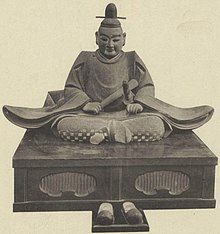Oda Nobuhide
Oda Nobuhide | |
|---|---|
 Statue of Oda Nobuhide at Banshō-ji | |
| Nickname(s) | Tiger of Owari 尾張の虎 |
| Born | 1510 Owari Province, Japan |
| Died | April 8, 1551 (aged 40–41) Ōsu Kannon, Nagoya |
| Allegiance | |
| Rank | Shugodai, Daimyo |
| Commands | Anjo Castle |
| Battles / wars | Battle of Azukizaka (1542) Battle of Kanōguchi (1547) |
| Spouse(s) | Tsuchida Gozen |
| Children | Oda Nobuhiro Oda Nobunaga Oda Nobuyuki Oda Nobukane Oda Nagamasu Oda Nobuharu Oda Nobutoki Oda Hidetaka Oichi Oinu |
| Other work | Buddhist monk |
Oda Nobuhide (織田 信秀, 1510 – 8 April 1551) was a Japanese daimyō and magistrate of the Sengoku period known as the father of Oda Nobunaga, regarded as the first "Great Unifier" of Japan. Nobuhide was a deputy shugo (Shugodai) of lower Owari Province and head of the Oda clan which controlled most of Owari.
Biography
Oda Nobuhide was born in 1510 in Owari Province, the eldest son of Oda Nobusada, the head of the Oda clan and a shugodai (deputy shugo) of the lower Owari area. Nobuhide became head of the Oda clan when Nobusada died in 1538, and became involved in open warfare as he was confronted to the north by Saitō Dōsan, the daimyō of Mino Province, and to the east by Imagawa Yoshimoto, the daimyō of Mikawa, Suruga, and Tōtōmi provinces.
In 1542 he defeated Imagawa Yoshimoto at First Battle of Azukizaka. Nobuhide managed to hold his own against his opponents, but was never able to fully unite Owari due to constant internal struggles within Oda clan, which prevented him from achieving a complete victory.
In 1547, Nobuhide was defeated at the Battle of Kanōguchi by Dōsan.[1] In 1548, Imagawa defeated Nobuhide in the Second Battle of Azukizaka and continued to expand his territory until 1560. However, in 1549, Nobuhide made peace with Dōsan by arranging a political marriage between his eldest son, Oda Nobunaga, and Saitō's daughter, Nōhime. Dōsan supported the marriage which allowed Nobuhide focus on facing Yoshimoto. In one of his moments of glory, Nobuhide managed to capture Matsudaira Motoyasu (later known Tokugawa Ieyasu), son of Matsudaira Hirotada as a hostage en route to Yoshimoto, and was thus able to gain some footholds into Mikawa.
Nobuhide died in 1551, and his remains are interred in a little-known alley near Osu Kannon temple in Nagoya.[2][3]
Succession controversy
Nobuhide's eldest son Oda Nobuhiro was illegitimate, and before his death designated the young Nobunaga, his eldest legitimate son, to succeed him as the head of the Oda clan and its small domain.[4][5] Nobunaga, who hardly knew his father and already had a bad reputation as a delinquent in Owari, arrived inappropriately dressed at Nobuhide's funeral and threw incense at the altar of the temple as he cursed his fate. Nobunaga's behavior and reputation resulted in almost all support that Nobuhide's retainers would have given him to disappear. Almost all Oda retainers and Nobunaga's mother Tsuchida Gozen favored his younger brother, Oda Nobuyuki, who was considered to be well-behaved and reputable. As a result, Nobunaga was left with support from Hirate Masahide and his father-in-law Saitō Dōsan, whom he had never met before, and a succession crisis. Many of Nobuhide's relatives and retainers attempted to usurp his heir, and it would take seven years for Nobunaga to consolidate his power within the Oda clan and finally unite Owari Province. Nobunaga eventually conquered most of Japan, beginning his campaign in Owari, and became known as the first of the three "Great Unifiers" of the Sengoku period.[6]
Family
- Father: Oda Nobusada
- Brothers:
- Oda Nobuyasu
- Oda Nobumitsu (1516–1556)
- Oda Nobutsugu
- Oda Nobuzane
- Sister: Lady Otsuya
- Wife: Tsuchida Gozen (1511-1594), who gave birth to four of his sons (Nobunaga, Nobuyuki, Nobukane and Oda Hidetaka).
- Sons:
- Oda Nobuhiro (died 1574) (illegitimate oldest son)
- Oda Nobunaga (1534–1582)
- Oda Nobuyuki (1536–1557)
- Oda Nobukane (1548–1614)
- Oda Nagamasu (1548–1622)
- Oda Nobuharu (1549–1570)
- Oda Nobutoki (died 1556)
- Oda Nobuoki
- Oda Hidetaka
- Oda Hidenari
- Oda Nobuteru
- Oda Nagatoshi
- Daughters:
- Oichi (1547–1583)
- Oinu, married Saji Nobutaka and mother of Saji Kazunari
See also
References
- ^ Turnbull, Stephen (1998). The Samurai Sourcebook. Cassell & Co. p. 211. ISBN 1854095234.
- ^ "Oda Nobuhide - SamuraiWiki". wiki.samurai-archives.com. Retrieved 2020-08-23.
- ^ Pitelka, Morgan (2016). Spectacular accumulation. University of Hawai'i Press. ISBN 978-0-8248-5736-3.
- ^ Sansom, George (1961). A History of Japan, 1334–1615. Stanford University Press. p. 276. ISBN 0804705259.
- ^ Titsingh, Isaac. (1834). Annales des empereurs du japon, p. 381.
- ^ kato. "Oda Nobuhide". Samurai World (in Japanese). Retrieved 2020-08-23.
- Titsingh, Isaac, ed. (1834). [Siyun-sai Rin-siyo/Hayashi Gahō, 1652], Nipon o daï itsi ran; ou, Annales des empereurs du Japon, tr. par M. Isaac Titsingh avec l'aide de plusieurs interprètes attachés au comptoir hollandais de Nangasaki; ouvrage re., complété et cor. sur l'original japonais-chinois, accompagné de notes et précédé d'un Aperçu d'histoire mythologique du Japon, par M. J. Klaproth. Paris: Oriental Translation Fund of Great Britain and Ireland. ...Link to digitized full text (in French)
